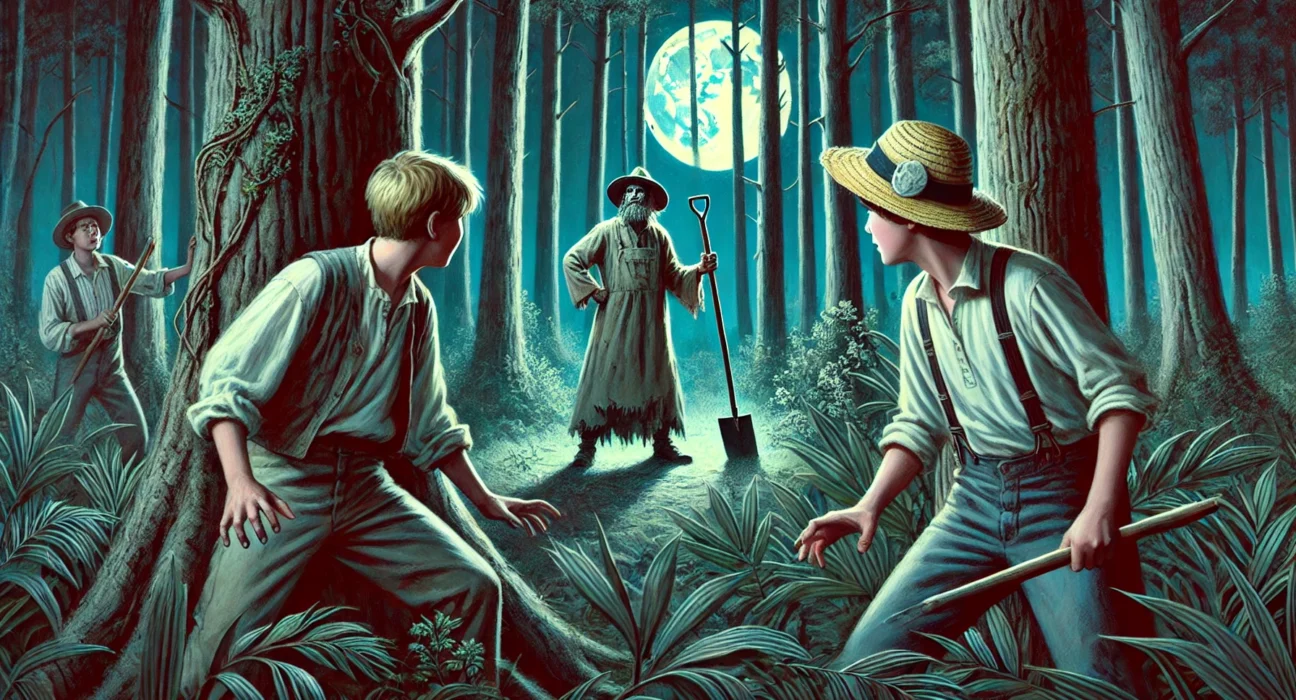“Tom Sawyer, Detective,” published in 1896, showcases Mark Twain’s mastery in weaving together adventure, mystery, and humor. Returning to the lively world of Tom Sawyer and Huck Finn, Twain takes readers on a thrilling journey set in the American South. This tale delves into the complexities of human nature, blending a gripping mystery with the innocent mischief and cunning of its young protagonists. Through Tom’s sharp wit and Huck’s loyalty, the story explores themes of justice, deception, and the enduring bond of friendship. Twain’s storytelling, rich with satire and vivid imagery, creates an engaging narrative that balances light-hearted adventure with deeper societal reflections.
Plot Summary
Spring fever had settled deep in Tom Sawyer and Huck Finn, making them yearn for new adventures and the thrill of the unknown. As luck would have it, their wish was granted when Tom’s Aunt Polly received a letter from Aunt Sally in Arkansas, requesting Tom’s presence to help alleviate some troubles. This was just the excuse they needed to leave behind the dullness of everyday life. Soon, the boys were on their way, filled with the anticipation of what lay ahead.
Upon reaching Aunt Sally’s farm, they were thrust into the midst of a local conflict that revolved around the Dunlap brothers—Brace and Jubiter. The richer of the two, Brace, had been seeking the hand of young Benny for months, only to be firmly rejected. The refusal had not sat well with him, given his wealth and influence in the area. To smooth things over, Uncle Silas had even hired Jubiter, Brace’s no-account brother, to help on the farm, though they could hardly afford him. This gesture only added tension, as Brace now had a personal stake in the family, and the air was thick with unspoken animosities.
The excitement truly began when Tom and Huck found themselves aboard a steamboat bound for Arkansas. Among the few passengers was a mysterious man who aroused Tom’s curiosity. This man, always eating alone in his room and rarely seen, was Phillips—or so he called himself. His strange behavior was like a red rag to a bull for Tom Sawyer. To Tom, a mystery unsolved was a story unfinished. With Huck’s help, they devised a plan to sneak into the man’s room, using the guise of delivering his breakfast. When they finally managed to get in, they were shocked to find that the man was not Phillips at all, but Jake Dunlap—Jubiter’s long-lost twin brother.
Jake, believed to have died years ago, was on the run from the law and from his own kind. He confessed to Tom and Huck that he was a part of a jewel heist, and now he was being hunted. The stolen diamonds, worth a small fortune, were hidden in a place even the most cunning thief wouldn’t think to look: the heels of his boots. Jake’s desperate plea for help struck a chord with the boys. There was danger, yes, but there was also the lure of solving a mystery and bringing justice. It was an adventure they couldn’t resist.
The boys’ involvement deepened as they helped Jake evade capture while staying one step ahead of his pursuers, including his own brother, Jubiter, who seemed to have a sinister plan of his own. Every step was fraught with danger, as they had to keep Jake’s identity a secret and ensure that the diamonds remained hidden. They found themselves caught in a web of deceit, with every move they made potentially leading them into the hands of Jake’s relentless enemies.
One night, while hiding out near Uncle Silas’s farm, they heard a commotion in the woods. Following the sounds, they stumbled upon a scene of violence—Jake had been attacked and left for dead. Tom and Huck, fearing the worst, decided to intervene. They couldn’t carry Jake back to the farm without raising suspicion, so they hid him in the nearby tobacco shed, tending to his wounds as best they could. They knew they had to act fast; if they didn’t solve the mystery and find the diamonds soon, Jake wouldn’t stand a chance against the men who were after him.
Determined to uncover the truth, the boys began investigating the connections between the Dunlaps and the local community. They discovered that Jubiter had been stirring up trouble with Uncle Silas, leading to numerous quarrels that puzzled everyone who knew the gentle preacher. It became clear that Jubiter was not only after the diamonds but also intent on discrediting Uncle Silas, possibly as part of a larger scheme to take over the farm and secure his place in the community.
As Tom and Huck pieced together the puzzle, they realized that the only way to ensure Jake’s safety was to recover the stolen diamonds and expose the villains’ true intentions. But with the diamonds still hidden in Jake’s boots, they needed a plan to retrieve them without alerting Jubiter and his accomplices. The boys decided to use a clever ruse to mislead Jubiter and his men, making it appear as though Jake had fled in a different direction. This bought them enough time to slip the diamonds out of the boots and secure them in a safe place.
With the diamonds in their possession, Tom and Huck laid a trap for Jubiter and his men. They set up a meeting, pretending to negotiate the diamonds’ return. When Jubiter and his accomplices arrived, they were caught off guard by Tom and Huck’s quick thinking and bravery. A thrilling chase ensued through the woods, with the boys using every trick they knew to outwit their pursuers. In the end, Tom and Huck managed to corner the villains, leaving them tied up and ready for the authorities to take over.
With Jubiter and his gang apprehended, the truth about the diamonds and the Dunlap brothers was finally revealed. The recovered jewels cleared Uncle Silas’s name, proving he had been an unwitting pawn in Jubiter’s schemes. The entire ordeal brought a sense of closure to the community, as the threat posed by the Dunlaps was eliminated. Tom and Huck had not only solved the mystery but had also restored peace to Aunt Sally’s farm.
The adventure brought Tom and Huck closer together, solidifying their friendship through the trials they faced. They had braved the unknown, outwitted dangerous men, and unraveled a mystery that had confounded even the adults around them. The boys had once again proven that their courage and cleverness were more than a match for any challenge that came their way. With the diamonds returned and the villains brought to justice, they could finally breathe easy, knowing they had made a difference. As they prepared to return home, they felt a renewed sense of camaraderie and a deeper appreciation for the thrill of adventure and the pursuit of justice.
Main Characters
- Tom Sawyer: Clever, adventurous, and resourceful, Tom is always eager for new experiences. His quick thinking and love for mystery drive the plot forward.
- Huck Finn: Loyal and brave, Huck complements Tom’s ingenuity with his own sense of courage and practicality. He is always ready to support Tom in their adventures.
- Jake Dunlap: Jake, the twin brother of Jubiter, is a complex character hiding from his criminal past. His plight and interactions with Tom and Huck add depth to the story.
- Jubiter Dunlap: The antagonist, Jubiter, is ruthless and determined to retrieve the stolen diamonds, showcasing the darker side of human nature.
- Aunt Sally: Tom’s kind-hearted aunt, who provides a safe haven for Tom and Huck. Her warmth and concern for the boys add a familial touch to the story.
Theme
- Adventure and Exploration: The story is driven by the boys’ desire for adventure, showcasing their love for discovery and excitement.
- Identity and Disguise: The use of disguises and mistaken identities highlights the themes of deception and the search for truth.
- Justice and Morality: Tom and Huck’s quest to right wrongs and help those in need reflects their strong moral compass and sense of justice.
- Friendship and Loyalty: The bond between Tom and Huck is central to the narrative, emphasizing the importance of loyalty and support in overcoming challenges.
Writing Style and Tone
Mark Twain’s writing style in “Tom Sawyer, Detective” is characterized by its wit, humor, and vivid descriptions. Twain employs a conversational tone, making the reader feel like a participant in the adventures. His use of dialect and regional vernacular adds authenticity to the setting and characters. The narrative is filled with sharp observations and satirical commentary on society, reflecting Twain’s critical eye and humorous take on human nature.
Twain’s storytelling is both engaging and thought-provoking, blending suspense with light-hearted moments. The plot is intricately woven with twists and turns, keeping readers on their toes. Twain’s ability to balance humor with serious themes makes “Tom Sawyer, Detective” a compelling and enjoyable read, continuing the legacy of his beloved characters in a new and exciting context.
We hope this summary has sparked your interest and would appreciate you following Celsius 233 on social media:
There’s a treasure trove of other fascinating book summaries waiting for you. Check out our collection of stories that inspire, thrill, and provoke thought, just like this one by checking out the Book Shelf or the Library
Remember, while our summaries capture the essence, they can never replace the full experience of reading the book. If this summary intrigued you, consider diving into the complete story – buy the book and immerse yourself in the author’s original work.
If you want to request a book summary, click here.
When Saurabh is not working/watching football/reading books/traveling, you can reach him via Twitter/X, LinkedIn, or Threads
Restart reading!








